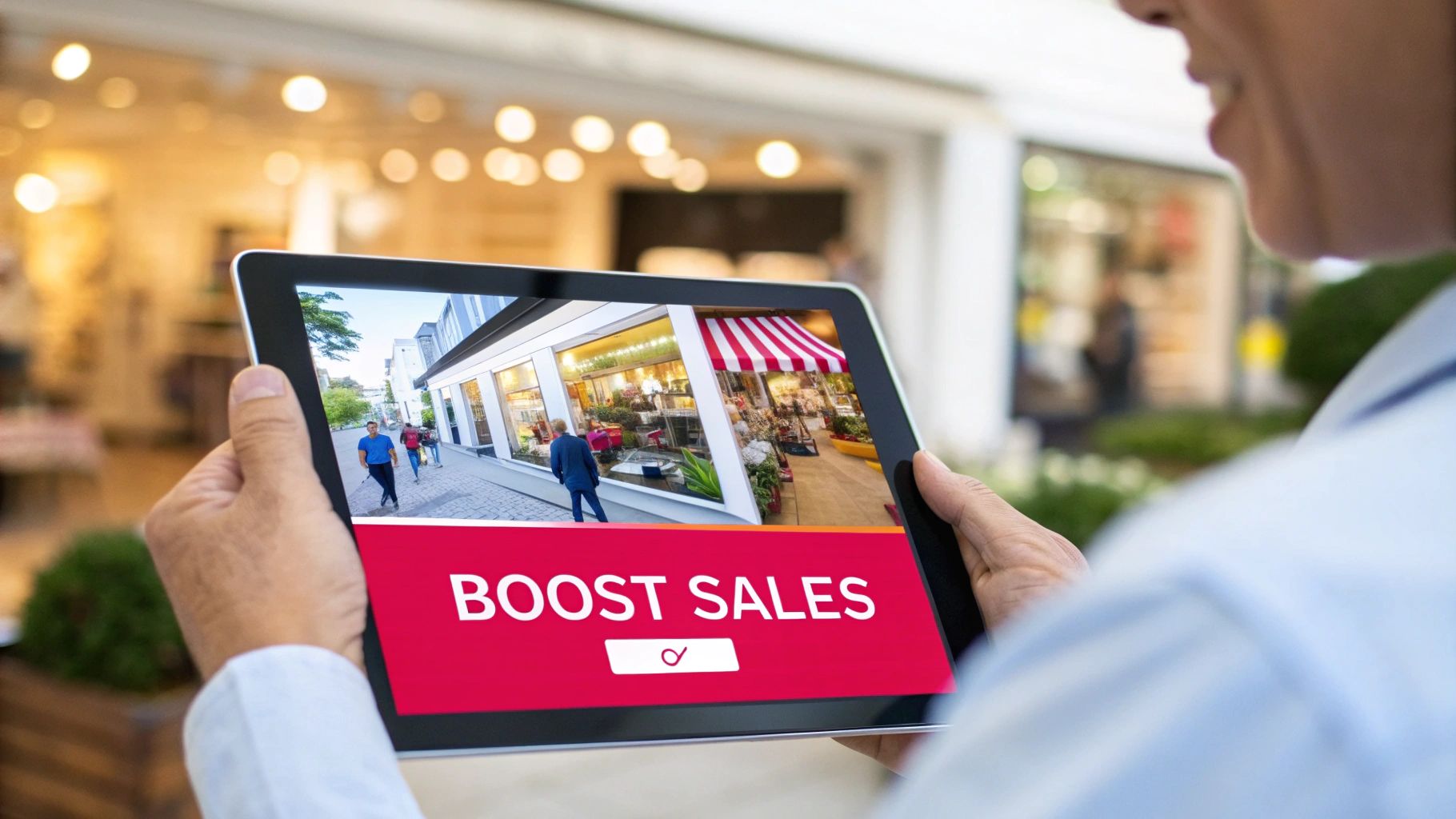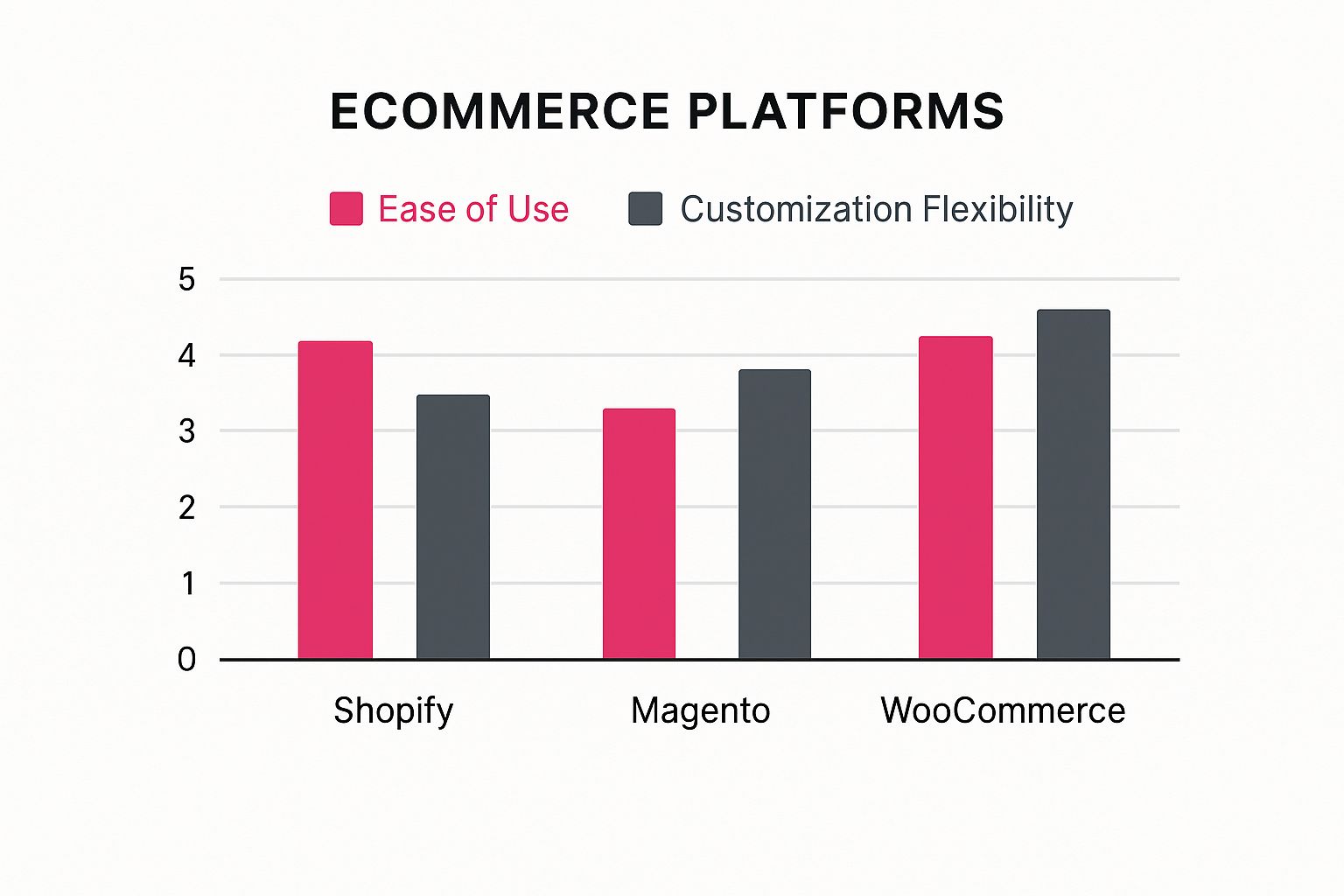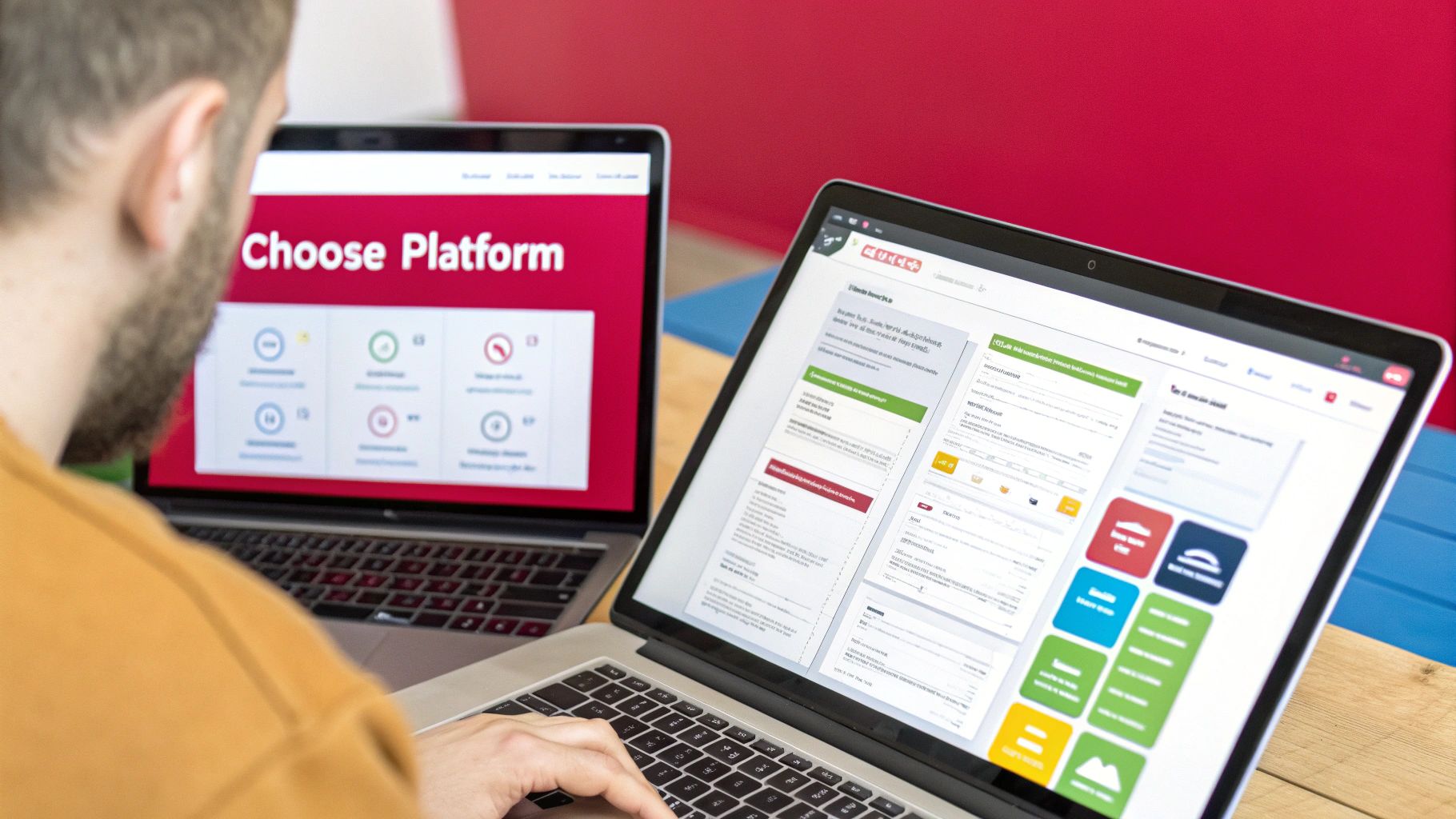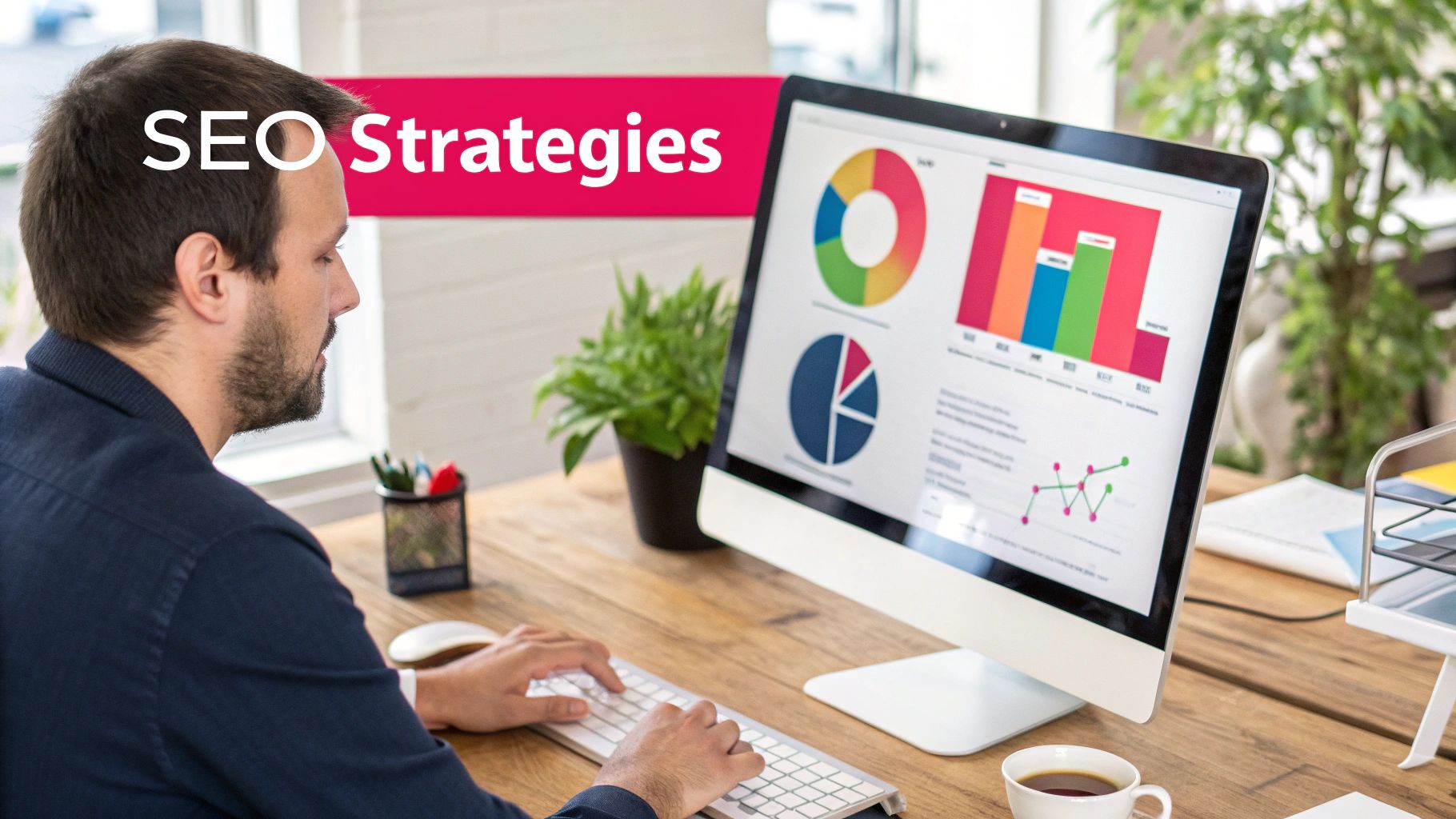Thinking about launching an e-commerce website in the UAE? You're looking at one of the most exciting and fast-growing digital markets on the planet. With a population of high-income earners, incredible internet infrastructure, and a government that genuinely champions digital business, the conditions are perfect for online retail.
For anyone from a solo entrepreneur to an established global brand, the opportunity here isn't just knocking—it's booming.
Why the UAE is a Goldmine for E-commerce
Before you get lost in the details of choosing a platform or designing your homepage, let's zoom out and look at why this market is so special. This isn't just another region with a growing economy. The UAE is a place strategically built for digital commerce, thanks to a unique mix of consumer habits, top-tier infrastructure, and smart government policies.
The numbers alone tell a powerful story. The UAE's e-commerce market is on a tear, projected to hit around USD 12.28 billion in 2025 and expected to climb to an impressive USD 21.18 billion by 2030. That's a compound annual growth rate (CAGR) of about 11.52%. If you want to dive deeper into the data, the analysis from Research and Markets is a great place to start.
You're Selling to a Plugged-In, Ready-to-Buy Audience
One of the biggest advantages is the customer base. The UAE has one of the highest internet penetration rates in the world—nearly everyone is online. And these aren't just casual browsers. Consumers here are tech-savvy, completely comfortable with online payments, and actively use social media and search to find their next purchase.
This digital fluency directly translates to sales. Here’s what’s driving their behaviour:
- Mobile is King: Most people here shop on their phones. M-commerce isn't just a side-channel; it's the main event. Your site absolutely must be flawless on mobile.
- Social Media Sells: Don't underestimate the power of platforms like Instagram, TikTok, and Snapchat. For many brands, this is where discovery happens and sales are closed.
- Convenience is Everything: UAE shoppers have high expectations. They want a smooth checkout process and, most importantly, fast and reliable delivery. Getting your logistics right from the start is critical.
The Government Has Rolled Out the Red Carpet
The UAE government isn't just a bystander; it's actively fuelling this digital growth. Ambitious projects like Dubai's Smart City initiative and the National Programme for Coders are all part of a larger plan to cement the nation's status as a global tech hub.
What does this mean for you? It means you're setting up shop in an ecosystem that encourages and supports digital businesses. The rules and infrastructure are constantly being improved to make life easier for online sellers, from streamlined business licensing to sophisticated digital payment systems.
This proactive approach from the government gives you a stable and predictable environment to grow in, which is a huge advantage compared to many other emerging markets.
Making Sure Your Big Idea Fits the Local Scene
Understanding these market dynamics is the first real step. It helps you take your business idea from a concept to something that genuinely connects with local buyers.
For example, if you're launching a fashion brand, you need to think about local tastes, the hot climate, and the cultural appreciation for both modesty and luxury. This will shape everything from your product selection to your marketing visuals.
Likewise, an online grocery store has to balance the demand for imported international favourites with fresh, local produce, all while meeting the expectation for same-day (or even same-hour) delivery. This is the kind of on-the-ground insight that separates a thriving store from one that just limps along. It ensures your business is built on what the market actually wants, not just on what you think is a good idea.
Getting Your E-commerce Licence in the UAE

Before a single dirham changes hands, you need to build your ecommerce website in UAE on a solid legal foundation. That means getting the right trade licence. It might sound intimidating, but it’s a straightforward path that secures your business and immediately builds trust with local customers.
The very first decision you'll make is choosing your business jurisdiction. This choice dictates your company's ownership structure, how and where you can operate, and your potential for growth down the line. Getting this right from the start saves a world of headaches and money.
Mainland vs. Free Zone: Where Do You Belong?
In the UAE, you essentially have two main options for setting up your e-commerce business: on the mainland or within one of the many specialised free zones. Each has its own distinct advantages, and the right choice really boils down to your specific business model and ambitions.
A mainland licence, issued by the Department of Economic Development (DED) in your chosen emirate, gives you the freedom to trade directly with any customer across the entire UAE, no strings attached. This is the way to go if you're planning on opening physical stores, managing your own local distribution, or engaging in a wide range of commercial activities on the ground.
On the other hand, free zone licences are often quicker to set up, more cost-effective, and come with attractive perks like 100% foreign ownership and tax exemptions. They're a fantastic option for businesses that are focused on international markets or operate purely online. The one catch is that to sell directly to customers on the UAE mainland from a free zone, you'll typically need to partner with a local distributor.
Choosing your jurisdiction is the single most critical decision at this stage. A mainland setup offers unrestricted market access within the UAE, while a free zone provides ownership benefits and is often faster to establish for globally-focused businesses.
The Practical Steps to Getting Licensed
Once you’ve settled on the mainland vs. free zone debate, the application process follows a fairly standard sequence. While the minor details can differ between emirates and specific free zone authorities, the core steps are largely the same.
First up, you’ll need to get your business name approved and clearly define your business activities. It's vital that the activities you list on your application are a perfect match for what your e-commerce store will actually do, whether it's selling fashion, electronics, or digital services.
Next comes the paperwork. You’ll need to prepare and submit a set of key documents, which usually includes:
- A completed application form with all the necessary details about your business and its owners.
- Passport copies for all shareholders and the appointed company manager.
- A concise business plan that outlines your e-commerce venture, its goals, and how you plan to operate.
This is also where a strong brand identity starts to pay off. A professionally developed brand can make your application and business plan far more convincing. Understanding the principles of cohesive https://grassrootscreativeagency.com/branding-abu-dhabi/ can help you make a much stronger first impression on the authorities.
Staying on the Right Side of the Law
Your licence is your ticket to operate, but staying legal means sticking to the UAE's consumer protection and data privacy laws. These rules are here to protect shoppers and ensure a fair marketplace, which is great news for any reputable business.
For any ecommerce website in UAE, key responsibilities include:
- Transparent Policies and Pricing: All your prices, including VAT and any other charges, must be crystal clear. Your return, refund, and shipping policies should be easy for customers to find and understand.
- Data Privacy: You must handle customer data with care, following the UAE's Personal Data Protection Law. This means being upfront about what information you collect and how you use it.
- Consumer Rights: Customers have a right to receive products exactly as described and to be protected from misleading advertising.
The UAE's retail e-commerce market is dominated by B2C sales, making up about 68% of the market share. This boom is powered by sky-high smartphone penetration and the slick experience offered by digital wallets and the 'UAE Pass' digital identity system. To tap into this massive consumer base, playing by the rules isn't just a requirement—it's a competitive advantage. You can dive deeper into the market dynamics by reading the full market report from Nexdigm.
Choosing Your Platform and Payment Solutions
The technology you choose is the very engine of your e-commerce business here in the UAE. Get it right, and you'll have a smooth, efficient operation that customers love. Get it wrong, and you'll be dealing with headaches and lost sales from day one.
Think of it this way: your platform and payment gateway are foundational. They dictate everything from how your store looks and feels to how easily a customer can give you their money. This isn't just a tech decision; it's a core business strategy. Let's dig into how to make the right choice for your venture.
Selecting the Right E-commerce Platform
The UAE market is flooded with options, from global giants to powerful open-source systems. The "best" one doesn't exist—only the one that's best for you. It all comes down to your budget, your technical comfort level, and where you see your business in a few years.
Most businesses find themselves weighing up three main contenders: Shopify, Adobe Commerce (which you might know as Magento), and WooCommerce.
Each one offers a different trade-off between simplicity and control.

As you can see, platforms like Shopify are built for speed and ease, making them perfect for getting off the ground quickly. On the other end, something like Magento gives you total creative freedom, but you'll need the technical muscle to make it happen.
Let’s look at these in a bit more detail.
-
Shopify: This is the go-to for most start-ups and SMEs for a reason. It's incredibly straightforward. You can have a professional, fully working store up and running in days, not weeks, without touching a line of code. Plus, its app store is a goldmine for connecting with local shipping carriers or marketing tools.
-
Adobe Commerce (Magento): This is the heavyweight champion for large, complex businesses. Because it's open-source, you can customise literally anything. If your vision includes bespoke features, managing multiple storefronts, or intricate B2B functions, Magento is probably your answer—just be prepared for the higher development costs and expertise it requires.
-
WooCommerce: If you're already running a website on WordPress, this is a brilliant option. It’s a free plugin that bolts a powerful shop right onto your existing site. It gives you a ton of flexibility, but the trade-off is that you're in charge of your own security, updates, and hosting, unlike an all-in-one solution like Shopify.
Choosing the right platform is a critical first step. The table below breaks down the key considerations for the UAE market to help you compare these options at a glance.
UAE E-commerce Platform Comparison
| Platform | Best For | Pricing Model | Local Payment Gateway Support | Ease of Use |
|---|---|---|---|---|
| Shopify | Start-ups & SMEs seeking a quick launch and ease of use. | Monthly subscription + transaction fees. | Excellent (Stripe, Telr, PayTabs plugins). | Very High |
| Adobe Commerce | Large enterprises with complex, custom requirements. | Open-source (free) or enterprise licence (costly). Custom development is the main cost. | High (Requires custom integration or extensions). | Low (Developer needed) |
| WooCommerce | Businesses with an existing WordPress site or those wanting high customisation on a budget. | Free plugin, but hosting, themes, and premium extensions add up. | Excellent (Many free and paid plugins available). | Medium (Some technical skill needed) |
Ultimately, the platform you select should align with your business goals, not just for today but for the future. Consider where you want to be in three years and choose a platform that can grow with you.
Integrating a Frictionless Payment Gateway
So, a customer has browsed your site and filled their basket. Fantastic! But the final, most delicate step is the checkout. A confusing or untrustworthy payment process is the fastest way to lose a sale. In the UAE, shoppers expect choice—credit cards, debit cards, digital wallets, and yes, still a high demand for Cash on Delivery (COD).
Your payment gateway does more than just process money; it builds trust. When a customer sees a familiar, secure payment option, it reassures them that their details are safe, which massively boosts your chances of completing the sale.
When you're looking at payment gateways for your ecommerce website in UAE, stick with providers that have a strong local foothold. Don't just get fixated on the transaction fees; look at the whole picture.
Here are a few of the key players you'll come across:
- Stripe: A global powerhouse known for its slick interface, powerful developer tools, and clear pricing. It handles AED transactions perfectly and is a favourite among modern, tech-savvy businesses.
- Telr: A home-grown UAE success story. They offer a complete package of payment solutions and are particularly good at supporting start-ups with flexible plans and multiple payment methods.
- PayTabs: Another regional champion with a huge presence across the Middle East. They are known for their rock-solid security and excellent customer support, making them a very reliable choice.
When you're comparing them, ask yourself these key questions:
- What are the real fees? Get a clear breakdown of per-transaction costs, plus any monthly or setup charges.
- Do they support AED natively? This is non-negotiable. You don't want your customers getting hit with surprise currency conversion fees.
- Are they secure? Make sure any provider is PCI DSS compliant. This is the industry standard for protecting card data.
- How easy is the setup? Check if they have a simple plug-in or app for your chosen e-commerce platform.
- How quickly do I get my money? Understand their payout schedule and how fast cash will land in your business bank account.
Pairing a scalable platform with a trusted, flexible payment gateway is the recipe for a solid technological foundation. It creates a seamless journey for your customers and gives you the reliable tools you need to run and grow your business in the UAE.
Making Your Store Feel Like Home for UAE Shoppers

If you launch a generic, one-size-fits-all website in the UAE, you’re setting yourself up for a tough ride. To actually connect with customers here, your store needs to feel like it was made just for them. This is what we call localisation, and it’s about much more than just translating your text. It’s about weaving your brand into the local culture and making it work for the way people shop here.
Think of it this way: true localisation is about respecting the market’s unique character. You need to adapt everything from your product photos and payment options to your delivery methods to match what local shoppers expect. That’s how you go from being just another website to a trusted, go-to brand in the UAE.
Build a Flawless Bilingual Experience
The UAE is a melting pot of cultures, but when it comes to business, Arabic and English are the two essential languages. Having a fully bilingual site isn't just a nice-to-have feature; it's a baseline requirement if you want to reach everyone.
And please, don't just plug in Google Translate and call it a day. That simply won’t cut it. You need professional, high-quality translations that get the tone and dialect right, especially for product descriptions and the checkout process where any confusion can kill a sale.
A deep dive into User Experience Design Fundamentals is a great place to start, as it will help you create a shopping journey that feels natural and intuitive. Make sure your language switcher is easy to find so users can flip between Arabic and English without any hassle.
Fine-Tune Your Content and Imagery for Local Tastes
Localisation goes right to the heart of your creative choices. The images you use, the tone of your marketing, and even the people you feature in your ads need to resonate with local cultural values.
Here are a few practical ideas to get you started:
- Imagery: Ditch the generic stock photos. Use visuals that reflect the local lifestyle, landmarks, and diverse population. If you’re a fashion brand, for instance, showcase modest yet stylish outfits alongside contemporary looks.
- Marketing Tone: Keep your communication respectful and family-oriented. Slang or an overly casual tone that works elsewhere might not land well here and could come across as unprofessional.
- Promotions and Holidays: Sync your marketing calendar with major local events. Think Ramadan, Eid al-Fitr, and UAE National Day. These are huge shopping periods, and you need tailored campaigns and offers ready to go.
A key piece of advice for anyone launching an e-commerce site in the UAE: customers here value authenticity. They can spot a generic international site from a mile away. Showing that you understand and respect their culture is one of the most powerful ways to build lasting brand loyalty.
Working with local creators is another fantastic way to get this right. For example, partnering with regional influencers ensures your content feels genuine and relevant. You can explore a detailed guide on how to make these partnerships work and learn more about successful influencer marketing in Dubai to connect with your audience on a deeper level.
Get Your Local Logistics and Payments Right
Even the most beautiful, culturally-aware website will fall flat if your backend operations can't deliver. Two things are absolutely critical: reliable local delivery and the right payment options.
Customers in the UAE expect fast, dependable delivery. Partnering with a trusted local courier isn't optional.
- Aramex: A regional powerhouse with an incredible network and a solid reputation.
- Fetchr: An innovative option that uses a customer's phone location for delivery instead of a formal address—super handy.
- Emirates Post: The official postal service, offering reliable and often more budget-friendly options.
Just as important is how you let people pay. While credit cards and digital wallets are on the rise, Cash on Delivery (COD) is still king for a huge part of the market. Many shoppers simply prefer the security of paying for an item once it’s physically in their hands.
If you don't offer COD, you could be waving goodbye to a massive chunk of potential customers. The smartest approach is to offer a mix: credit/debit cards, digital wallets like Apple Pay, and COD. This flexibility removes any friction at checkout and makes every customer feel comfortable, which is exactly what you need to maximise sales.
Marketing Your Ecommerce Website in the UAE
Building a beautiful, localised e-commerce website is a fantastic achievement, but it's only half the battle. Now comes the real challenge: getting your ideal customers to actually find it. A brilliant site without traffic is just a digital billboard in the desert. This is where a smart, UAE-specific marketing strategy comes into play, turning your online store into a thriving hub of activity.
The good news is you’re entering a market with enormous potential. According to recent research, the UAE e-commerce market hit a value of USD 125 billion in 2024. And it’s not slowing down—projections show it skyrocketing to USD 776.2 billion by 2033, growing at an exceptional rate of 21.4% annually. This phenomenal growth is a direct result of strong government support for digital transformation, creating the perfect environment for your marketing efforts to succeed.
Mastering Search Engine Optimisation for Google.ae
When shoppers in the UAE want something, their first stop is almost always Google.ae. This is why making sure your ecommerce website in UAE appears high up in those search results is essential for driving consistent, high-quality traffic to your store.
Getting this right—what we call search engine optimisation (SEO)—starts with understanding what your customers are actually searching for.
Local keyword research is your first and most critical task. You need to think like your customer. Are they searching in English, Arabic, or a mix of both (Arabizi)? Tools like Google Keyword Planner are a good starting point to uncover the exact phrases people are using.
For instance, someone looking for a specific type of perfume might search for:
- "buy oud perfume in Dubai"
- "أفضل عطور العود للرجال" (best oud perfumes for men)
- "local perfume brands UAE"
Once you have these keywords, you need to weave them naturally into your site's content. Think product titles, detailed descriptions, and even your blog posts. This is how you signal to Google what your pages are about, helping you rank for those valuable searches.
Connecting with Customers on Social Media
In the UAE, social media isn't just for staying in touch with friends; it’s a major driver of commerce. Platforms like Instagram, TikTok, and even Snapchat are where your potential customers spend a significant amount of their time, making them incredibly powerful channels for your brand.
It's not enough to just post product photos and call it a day. Your social media presence needs to be genuinely engaging and provide real value. Think about creating content that tells a story, showcases your products in real-life situations, or shares behind-the-scenes glimpses of your brand.
Visuals are everything here. For a comprehensive guide on leveraging them, it's worth learning about using Pinterest for business in e-commerce, as the same principles of high-quality visuals and inspiring content apply directly to Instagram. Use a mix of Reels, Stories, and polished feed posts to capture attention.
The key to social media success in the UAE is authenticity. Partnering with local influencers who genuinely love your products can be far more effective than generic ads. Their endorsement acts as a powerful form of social proof, building instant trust with their followers.
Nurturing Loyalty with Direct Communication
Attracting a new customer is great, but getting them to come back and buy again is what builds a sustainable business. Direct communication channels like email and WhatsApp are your best friends for fostering this kind of loyalty.
These channels allow you to build a personal connection with your customers, turning one-time buyers into lifelong fans.
Consider setting up an automated email series to welcome new subscribers, remind customers about items they've left in their basket, or follow up after a purchase to ask for a review. These small, personalised touches make your customers feel valued, not just like another order number.
WhatsApp marketing is also incredibly powerful in the UAE. You can use it to:
- Send order confirmations and shipping updates.
- Announce exclusive flash sales to your most loyal customers.
- Provide quick, conversational customer support.
This direct line of communication is invaluable. When you combine strong SEO, engaging social media, and a smart retention strategy, you create a powerful marketing engine. If you're looking for expert guidance, exploring partnerships with top-tier digital marketing firms can provide the strategic support needed to accelerate your growth and ensure your brand not only reaches its audience but also builds lasting relationships.
Answering Your Top Questions About Starting an Online Store in the UAE

Jumping into a new e-commerce venture always brings up a few practical questions. It's completely normal. Let's tackle some of the most common queries I hear from entrepreneurs setting up their ecommerce website in UAE. Getting these points clear will help you navigate the final hurdles with a lot more confidence.
These questions usually get right to the heart of setting up shop—from the nitty-gritty of legal requirements to the daily operational headaches of serving a savvy market.
Do I Need a Physical Office for an E-commerce Licence?
This is a big one, and the answer is great news for anyone managing a tight budget. There's a common myth that you need a traditional, expensive office to get your e-commerce licence, but that's not always true.
Many free zones across the UAE offer flexible solutions that perfectly satisfy the commercial address requirement. Think virtual office packages or access to a 'flexi-desk' facility. This gives you a legitimate business address without locking you into a costly long-term lease.
A word of caution, though: the rules can change quite a bit from one jurisdiction to another. Before you put any money down, double-check the specific requirements with your chosen licensing authority.
The UAE’s business infrastructure is built to be flexible, which is a massive advantage for new entrepreneurs. Options like virtual offices make it much easier and more affordable to get your online business off the ground legally. Just make sure you do your homework on the specific authority you're dealing with.
What is the Best Way to Manage Shipping and Logistics?
When you're just starting, trying to manage inventory, pack orders, and handle deliveries yourself can become a full-time job. It’s a fast track to burnout. This is exactly why so many successful start-ups outsource this crucial function right from the beginning.
Partnering with a third-party logistics (3PL) provider is usually the smartest move. Companies like Aramex or Fetchr are experts in the entire fulfilment process. They’ll take care of everything, from warehousing your products to making sure that last-mile delivery gets to your customers on time.
Better yet, most of these 3PLs offer clean integrations with major e-commerce platforms like Shopify, which automates a huge chunk of your order-fulfilment workflow. Later, as your business grows and order volumes climb, you can always re-evaluate. You might find that a hybrid model or even setting up your own in-house delivery for key cities makes sense for better control over the customer experience.
Is Cash on Delivery Still Essential in the UAE?
Yes, 100%. While digital payments are growing faster than ever, Cash on Delivery (COD) is still non-negotiable for any serious ecommerce website in UAE.
A huge part of the market here still prefers the comfort and security of paying for goods only when they have them in their hands. If you don't offer COD, you're practically inviting customers to abandon their baskets, especially when you're a new brand trying to build trust.
The best strategy? Give your customers plenty of choice. Offer COD right alongside credit/debit card processing and popular digital wallets. This creates a smooth, frictionless checkout for every kind of shopper.
Ready to build an e-commerce website that truly connects with the UAE market? Grassroots Creative Agency specialises in creating data-driven digital strategies, from stunning web design to targeted marketing campaigns that deliver real results. Let us help you turn your vision into a successful online store. Learn more about our services and get started today.







